Cadillac XTS Platinum concept – Click above for high-res image gallery
For the past decade, Cadillac has been transforming itself from a brand that built big, floaty old-school luxury cars for old-school customers into something much more contemporary to compete with the best premium brands from Europe. Unfortunately for General Motors, the process has been only partially successful. The Escalade has been a huge sales success for the brand and the CTS has achieved both critical and commercial acclaim. The STS and the first generation SRX, however, never quite struck a chord with the market and the DTS is just old.
A new SRX debuted last year, but now it's time to flesh out the rest of the lineup. The CTS in sedan, coupe and sportwagon forms is one of Autoblog's favorites. It's time to spread that goodness to both a smaller and larger sedan. Last August we saw styling concepts of both those cars, dubbed the ATS and XTS during a visit to the GM design studios. GM isn't publicly showing the 3 series-sized ATS just yet, but the XTS is debuting today at the Detroit Auto Show. The XTS Platinum concept is a preview of Cadillac's new flagship that's expected to start production in early 2012. Read on after the jump to learn all about it.
In the XTS we finally get a full-size interpretation of Cadillac's "Art & Science" design language that features the same bold looks embodied in the CTS. The STS is considered by most to be a watered down example of Cadillac's signature design and the DTS is really just a warmed over version of the old de Ville. The face of the XTS, which will replace both, is derived from the 2003 Sixteen concept, including the grille and slim vertical headlights that extend into the top edge of the fender.
From there back the look of the Sixteen concept is discarded. In profile, the XTS has a short hood with the base of the steeply raked windshield rising up from near the trailing edge of the front wheel arch. The greenhouse is particularly long in proportion to the body with the backlight sloping back into the short rear deck where it meets the gently rising belt-line. Below the belt-line is an undercut crease echoing the one on the new SRX, but thankfully without the crossover's fake fender.
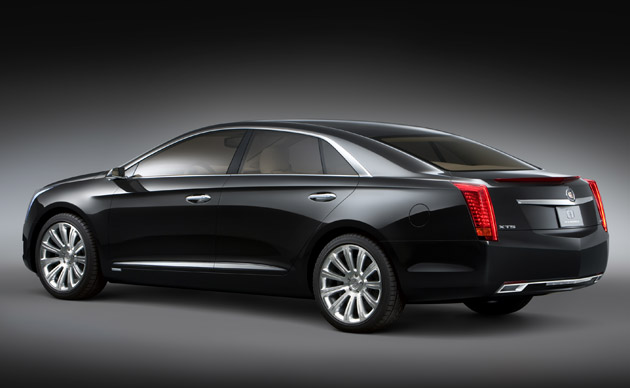
Dimensionally, the XTS slots in between the current STS and the DTS, although it's closer to the larger DTS. The overall length and wheelbase are both four inches shorter than the DTS. The new sedan is also 1.5 inches taller than the older sedans but the proportions do a good job of hiding the height.
Inside the XTS gets a new look compared to recent Cadillacs. Instead of the navigation screen popping up out of the top of the center stack as it does in the CTS and SRX, there are a pair of organic light-emitting diode (OLED) displays for the instrument cluster and integrated navigation screen. The pop-up screen setup does return in the back seat where the entertainment system displays rise up behind the headrests. As you would expect of a flagship for a luxury brand, the rest of interior is finished in premium woods, leathers and laser-etched suede.
When we first saw the XTS last summer, Cadillac provided no details about the car aside from it having all-wheel drive. Last week when we spoke with GM hybrid spokesman Brian Corbett about the company's plug-in two-mode hybrid program (PHEV), he told us that while no production announcements were being made yet, the system would first go into a premium brand vehicle and it would show up in one of the Detroit concepts. We now know that the XTS Platinum is that concept in question. We had an opportunity to briefly drive one of the Vue prototypes last summer and the XTS Platinum concept is equipped with the same system including the direct-injected 3.6-liter V6 that is now widely used in GM vehicles.
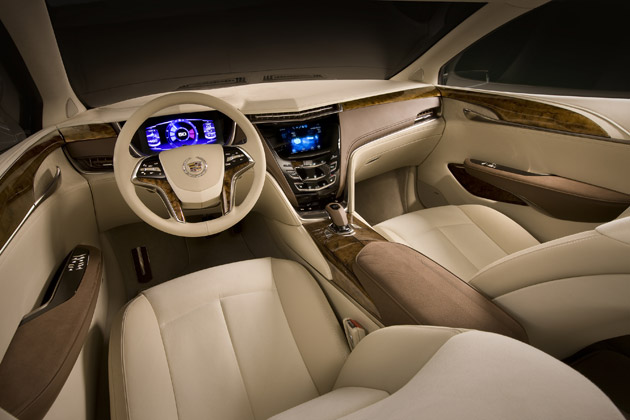



In order to provide the plug-in capability, the nickel metal hydride battery pack has been replaced with a liquid-cooled lithium ion pack. The battery will use the same lithium cells going into the Chevrolet Volt battery pack, but with a smaller 8 kilowatt-hour capacity. Because this is "just a concept," no battery capacity is listed but Corbett tells us that LG Chem/CPI are still the intended supplier for whatever vehicle gets the PHEV system.
Since the electric drive capacity of the two-mode system is not sized to propel the vehicle electrically at all speeds, the system allows pure electric drive only at speeds only below 40 mph. Under moderate to heavy acceleration or at higher speeds, it is also capable of providing increased electric power blending as long as the lithium battery has not been depleted of its plug-in charge. Based on the size of the battery from the VUE, the XTS should be able to go about 20 miles with this enhanced hybrid capability before reverting back to standard hybrid performance. During that period, the PHEV should roughly double the ,mileage of a conventional non-hybrid model with that improvement dropping to about 50 percent after the plug-in charge is depleted.
The net combined output of the V6 and hybrid system is listed at 350 horsepower and 295 pound-feet of torque. Thanks to the instant torque of the electric drive, that pulling power should also be more available at low speeds where it would be most appreciated in a vehicle of this size.
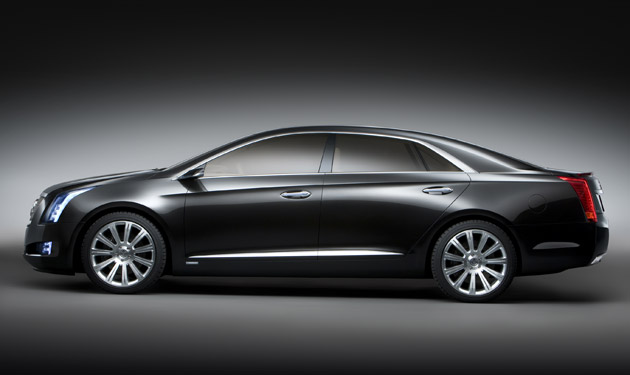
Recently it was reported that Mercedes-Benz would launch its first production plug-in hybrid system in the next generation S-Class. The XTS Platinum concept is slightly shorter but taller and wider than the current S-Class and may go on sale at the same time as the new S. Today's S400 hybrid also uses a ,3.5-liter V6 albeit with a much less powerful electric drive system and battery, so the new plug-in version should make for a very interesting comparison, assuming Cadillac opts to build this car.
The platform of the XTS is believed to be an upgraded variant of GM's Epsilon II architecture, so it should prove to be quite capable when it comes to dynamic maneuvers. In keeping with its branding, the concept also gets some extra niceties such as the magnetic ride damping system found on the CTS-V and the Corvette ZR1. As the flagship of the Cadillac brand, the XTS would also likely use the Haldex-based torque-vectoring all-wheel-drive system found in the new SRX 2.8-liter turbo, the departed Saab Turbo-X and the Opel Insignia OPC.
At the end of the day, the XTS Platinum concept probably provides a good look at the production car that will take over for Cadillac's two biggest cars. Questions that remain include how well you think this concept wears the brand's Art & Science design language and weather or not enough of the Sixteen concept's sizzle has found its way into the XTS.
CADILLAC UNVEILS THE XTS PLATINUM CONCEPT
• A new study re-imagining the luxury sedan, showcasing the progression of the Cadillac Art and Science philosophy
• Designed from the inside out, featuring a new concept for the interface between the driver and the auto electronics
• Plug-in hybrid system is matched with a 3.6L V-6 and all-wheel drive for dynamic and efficient performance
DETROIT – Cadillac unveiled the XTS Platinum Concept at the 2010 North American International Auto Show, suggesting a new paradigm for the luxury sedan of the future. The concept showcases Cadillac's emerging top-of-the-line Platinum series of models, emphasizing new expressions of luxury and technological features, including a plug-in hybrid propulsion system.
The XTS Platinum Concept was designed from the inside out, re-imagining the luxury sedan as a personal headquarters, built for efficiency, luxury and connectivity. The concept introduces a new approach to in-car electronics that improves the form and function of the car's entertainment, navigation and information systems.
"The XTS Platinum concept is the next expression of Cadillac's Art and Science execution philosophy, reflecting our drive to deliver the latest innovations in the most artful manner," said Bryan Nesbitt, Cadillac general manager. "We envisioned this concept as an automotive personal headquarters, using advanced technology to enable new levels of connectivity and luxury."
The XTS Platinum Concept uses Cadillac's 3.6L V-6 Direct Injection gas engine, paired with a plug-in hybrid system. The plug-in technology enables the battery to fully charge from a standard electrical outlet, enabling pure electric propulsion in many driving situations, especially urban commutes in which fuel efficiency may double that of a conventional hybrid.
Traditional luxury sedans were defined by elegant interiors and Cadillac's XTS Platinum Concept propels that formula into the future. It delivers new approaches to luxury within a design that combines fine craftsmanship with customer-driven innovation. Like the current Platinum Edition products, such as Escalade Platinum and the STS and DTS Platinum sedans, the interior is based on hand cut-and-sewn materials. The XTS Platinum Concept injects more contemporary forms and themes into the interior design, including the use of Organic Light-Emitting Diode (O-LED) displays in place of traditional gauges and screens.
The concept previews a new integration philosophy guiding the development of future models with respect to in-car electronics. The intent is to progress Cadillac's intuitive in-car electronics systems, typified by the deployable touch-screen navigation system that has been highly acclaimed in the brand's CTS and SRX product lines. The XTS Platinum Concept previews this strategy via the minimization of traditional buttons and switches. Designers blended the display screens into a flowing instrument panel. They call it a "dead front" design, because the panels appear black until the car is turned on and the screens illuminate. The instrument panel itself reflects the XTS Platinum's other focus – uncompromising luxury and attention to detail on the interior.
"The Platinum distinction in Cadillac means the fullest extent of luxury and technology and we've tried to reach even further with this concept," said Clay Dean, Cadillac design director. "Just as the technology pushes the boundaries of what a Cadillac can offer, so do the details that make the XTS Platinum Concept an uncompromising experience."
The interior takes inspiration from nature, specifically the intricate layers of petals that combine to form an orchid. Cadillac designers translated that into a layered and detailed interior. Light cream is the cabin's primary color and is contrasted with darker elements, such as the steering wheel and an overhead console motif that runs the length of interior's roof. The console is made of a richly finished wood and houses lighting features.
Premium leather seats include a new style of automotive suede, with a laser-etched pattern. The patterned material adorns the center sections of the seats and accents the door trim. Thoughtfully detailed stitching is used throughout the interior, including the seats, instrument panel and door panels. Passengers in the spacious rear compartment of the XTS Platinum Concept also have access to the car's connectivity feature, along with a range of infotainment choices.
"We never lost sight of the fact that a large luxury sedan needs to be spacious and accommodating," said Dean. "Passengers will find generous headroom, legroom and knee space, along with the technology elements that make the drive more productive."
A new proportion
The XTS Platinum Concept has a distinctive proportion that transcends the traditional aesthetic of luxury sedans and carries the brand's Art and Science design in a more progressive manner. The unique proportion supports the "inside out" design priority, while creating a sleek profile that complements the car's advanced technology elements and necessary aerodynamics.
"The XTS Platinum Concept design artfully conveys its focus on functionality through technology," said Dean. "It is the antithesis of the conventional three-box sedan, suggesting the active evolution of Cadillac's design language."
A sweeping profile culminates in a short, high deck lid that meets the XTS Platinum Concept's aerodynamic needs – including a rear spoiler mounted on the deck lid, incorporating the center high-mounted stop lamp. A high, sloping beltline gestures the vehicle forward, suggesting motion, while the fenders flare outward wrapping tightly around 20-inch wheels and tires. The wheel-to-body proportion was carefully tailored to visually communicate the car's all-wheel-drive chassis.
Like the interior, the exterior elements are precisely tailored and elegantly detailed. Brushed billet aluminum trim is used selectively and the 20-inch, 11-spoke wheels feature a brushed aluminum face accented with bright inserts within the spokes. The wheels are wrapped with special Bridgestone tires that were created specifically for the XTS Platinum Concept.
Signature elements essential to Cadillac's Art and Science design language include vertical headlamp and taillamps, with integrated light pipes and richly detailed lighting components. The headlamps feature light-emitting diode technology for bright illumination that requires less energy, as well as Cadillac's Adaptive Forward Lighting technology, which turns the headlamps with the direction of the front wheels for greater visibility in turns.
Purposeful and efficient performance
The XTS Platinum concept's plug-in hybrid electric propulsion system (PHEV) builds on the experience Cadillac has gained with the Escalade Hybrid and Escalade Platinum Hybrid flagship models. The plug-in capability boosts the car's electric-only driving capability, offering additional battery energy capacity and enabling it to recharge from a standard external electrical outlet. The key benefit of external plug-in recharging is that in many situations – such as overnight parking – the battery can fully recharge in roughly five hours while the car is not in use. The plug-in system operates at maximum efficiency when operating on power the battery has drawn from the electric grid. In some conditions, such as urban commutes, drivers can experience efficiency that doubles that of conventional hybrids.
At higher speeds or when conditions demand it, such as brisk acceleration, a combination of engine power and electric power or engine power only, propels the vehicle. The combination of the Direct Injection V-6 engine and the PHEV system featuring fully electric variable drive provides a spirited driving experience. The system provides an estimated 350 horsepower (260 kW) and 295 lb.-ft. of torque (400 Nm).
Magnetic Ride Control (MRC) enables the XTS Platinum Concept to deliver superior road-holding performance while maintaining luxury car composure in "regular" driving conditions. It uses shocks controlled by advanced magneto-rheological technology, rather than mechanical valves, to greatly accelerate response time and precision.
MRC uses electronic sensors at all four wheels to literally "read the road" every millisecond, making constant adjustments to damping to create virtually instantaneous and extremely precise control of body motions.
An advanced, specially calibrated all-wheel-drive system ensures optimal traction in wet and slippery conditions, and helps deliver maximum traction while cornering. Four-wheel disc brakes, with four-channel ABS, StabiliTrak stability control and full-function traction control complete the drivetrain details.
"The XTS Platinum Concept was designed to deliver an engaging driving experience without compromising the functional features, space and comfort customers seek in a luxury car," said Nesbitt. "It is a new vision of luxury that uses advanced technology to deliver functionality efficiently and rewardingly."
• A new study re-imagining the luxury sedan, showcasing the progression of the Cadillac Art and Science philosophy
• Designed from the inside out, featuring a new concept for the interface between the driver and the auto electronics
• Plug-in hybrid system is matched with a 3.6L V-6 and all-wheel drive for dynamic and efficient performance
DETROIT – Cadillac unveiled the XTS Platinum Concept at the 2010 North American International Auto Show, suggesting a new paradigm for the luxury sedan of the future. The concept showcases Cadillac's emerging top-of-the-line Platinum series of models, emphasizing new expressions of luxury and technological features, including a plug-in hybrid propulsion system.
The XTS Platinum Concept was designed from the inside out, re-imagining the luxury sedan as a personal headquarters, built for efficiency, luxury and connectivity. The concept introduces a new approach to in-car electronics that improves the form and function of the car's entertainment, navigation and information systems.
"The XTS Platinum concept is the next expression of Cadillac's Art and Science execution philosophy, reflecting our drive to deliver the latest innovations in the most artful manner," said Bryan Nesbitt, Cadillac general manager. "We envisioned this concept as an automotive personal headquarters, using advanced technology to enable new levels of connectivity and luxury."
The XTS Platinum Concept uses Cadillac's 3.6L V-6 Direct Injection gas engine, paired with a plug-in hybrid system. The plug-in technology enables the battery to fully charge from a standard electrical outlet, enabling pure electric propulsion in many driving situations, especially urban commutes in which fuel efficiency may double that of a conventional hybrid.
Traditional luxury sedans were defined by elegant interiors and Cadillac's XTS Platinum Concept propels that formula into the future. It delivers new approaches to luxury within a design that combines fine craftsmanship with customer-driven innovation. Like the current Platinum Edition products, such as Escalade Platinum and the STS and DTS Platinum sedans, the interior is based on hand cut-and-sewn materials. The XTS Platinum Concept injects more contemporary forms and themes into the interior design, including the use of Organic Light-Emitting Diode (O-LED) displays in place of traditional gauges and screens.
The concept previews a new integration philosophy guiding the development of future models with respect to in-car electronics. The intent is to progress Cadillac's intuitive in-car electronics systems, typified by the deployable touch-screen navigation system that has been highly acclaimed in the brand's CTS and SRX product lines. The XTS Platinum Concept previews this strategy via the minimization of traditional buttons and switches. Designers blended the display screens into a flowing instrument panel. They call it a "dead front" design, because the panels appear black until the car is turned on and the screens illuminate. The instrument panel itself reflects the XTS Platinum's other focus – uncompromising luxury and attention to detail on the interior.
"The Platinum distinction in Cadillac means the fullest extent of luxury and technology and we've tried to reach even further with this concept," said Clay Dean, Cadillac design director. "Just as the technology pushes the boundaries of what a Cadillac can offer, so do the details that make the XTS Platinum Concept an uncompromising experience."
The interior takes inspiration from nature, specifically the intricate layers of petals that combine to form an orchid. Cadillac designers translated that into a layered and detailed interior. Light cream is the cabin's primary color and is contrasted with darker elements, such as the steering wheel and an overhead console motif that runs the length of interior's roof. The console is made of a richly finished wood and houses lighting features.
Premium leather seats include a new style of automotive suede, with a laser-etched pattern. The patterned material adorns the center sections of the seats and accents the door trim. Thoughtfully detailed stitching is used throughout the interior, including the seats, instrument panel and door panels. Passengers in the spacious rear compartment of the XTS Platinum Concept also have access to the car's connectivity feature, along with a range of infotainment choices.
"We never lost sight of the fact that a large luxury sedan needs to be spacious and accommodating," said Dean. "Passengers will find generous headroom, legroom and knee space, along with the technology elements that make the drive more productive."
A new proportion
The XTS Platinum Concept has a distinctive proportion that transcends the traditional aesthetic of luxury sedans and carries the brand's Art and Science design in a more progressive manner. The unique proportion supports the "inside out" design priority, while creating a sleek profile that complements the car's advanced technology elements and necessary aerodynamics.
"The XTS Platinum Concept design artfully conveys its focus on functionality through technology," said Dean. "It is the antithesis of the conventional three-box sedan, suggesting the active evolution of Cadillac's design language."
A sweeping profile culminates in a short, high deck lid that meets the XTS Platinum Concept's aerodynamic needs – including a rear spoiler mounted on the deck lid, incorporating the center high-mounted stop lamp. A high, sloping beltline gestures the vehicle forward, suggesting motion, while the fenders flare outward wrapping tightly around 20-inch wheels and tires. The wheel-to-body proportion was carefully tailored to visually communicate the car's all-wheel-drive chassis.
Like the interior, the exterior elements are precisely tailored and elegantly detailed. Brushed billet aluminum trim is used selectively and the 20-inch, 11-spoke wheels feature a brushed aluminum face accented with bright inserts within the spokes. The wheels are wrapped with special Bridgestone tires that were created specifically for the XTS Platinum Concept.
Signature elements essential to Cadillac's Art and Science design language include vertical headlamp and taillamps, with integrated light pipes and richly detailed lighting components. The headlamps feature light-emitting diode technology for bright illumination that requires less energy, as well as Cadillac's Adaptive Forward Lighting technology, which turns the headlamps with the direction of the front wheels for greater visibility in turns.
Purposeful and efficient performance
The XTS Platinum concept's plug-in hybrid electric propulsion system (PHEV) builds on the experience Cadillac has gained with the Escalade Hybrid and Escalade Platinum Hybrid flagship models. The plug-in capability boosts the car's electric-only driving capability, offering additional battery energy capacity and enabling it to recharge from a standard external electrical outlet. The key benefit of external plug-in recharging is that in many situations – such as overnight parking – the battery can fully recharge in roughly five hours while the car is not in use. The plug-in system operates at maximum efficiency when operating on power the battery has drawn from the electric grid. In some conditions, such as urban commutes, drivers can experience efficiency that doubles that of conventional hybrids.
At higher speeds or when conditions demand it, such as brisk acceleration, a combination of engine power and electric power or engine power only, propels the vehicle. The combination of the Direct Injection V-6 engine and the PHEV system featuring fully electric variable drive provides a spirited driving experience. The system provides an estimated 350 horsepower (260 kW) and 295 lb.-ft. of torque (400 Nm).
Magnetic Ride Control (MRC) enables the XTS Platinum Concept to deliver superior road-holding performance while maintaining luxury car composure in "regular" driving conditions. It uses shocks controlled by advanced magneto-rheological technology, rather than mechanical valves, to greatly accelerate response time and precision.
MRC uses electronic sensors at all four wheels to literally "read the road" every millisecond, making constant adjustments to damping to create virtually instantaneous and extremely precise control of body motions.
An advanced, specially calibrated all-wheel-drive system ensures optimal traction in wet and slippery conditions, and helps deliver maximum traction while cornering. Four-wheel disc brakes, with four-channel ABS, StabiliTrak stability control and full-function traction control complete the drivetrain details.
"The XTS Platinum Concept was designed to deliver an engaging driving experience without compromising the functional features, space and comfort customers seek in a luxury car," said Nesbitt. "It is a new vision of luxury that uses advanced technology to deliver functionality efficiently and rewardingly."
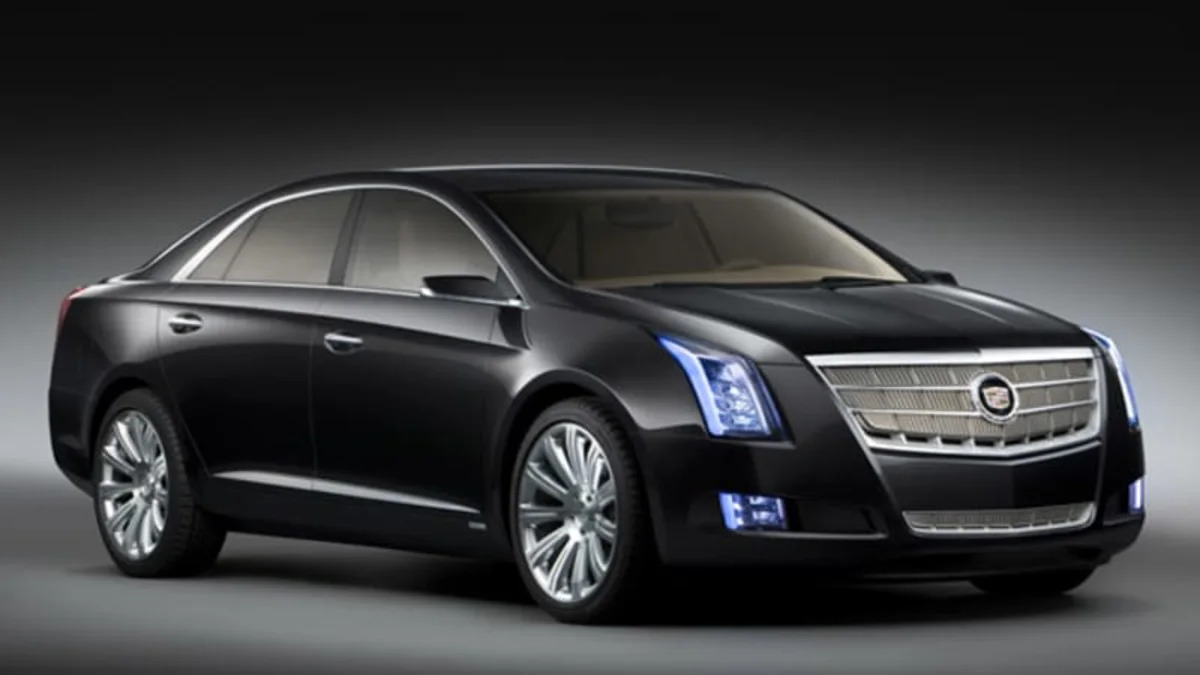
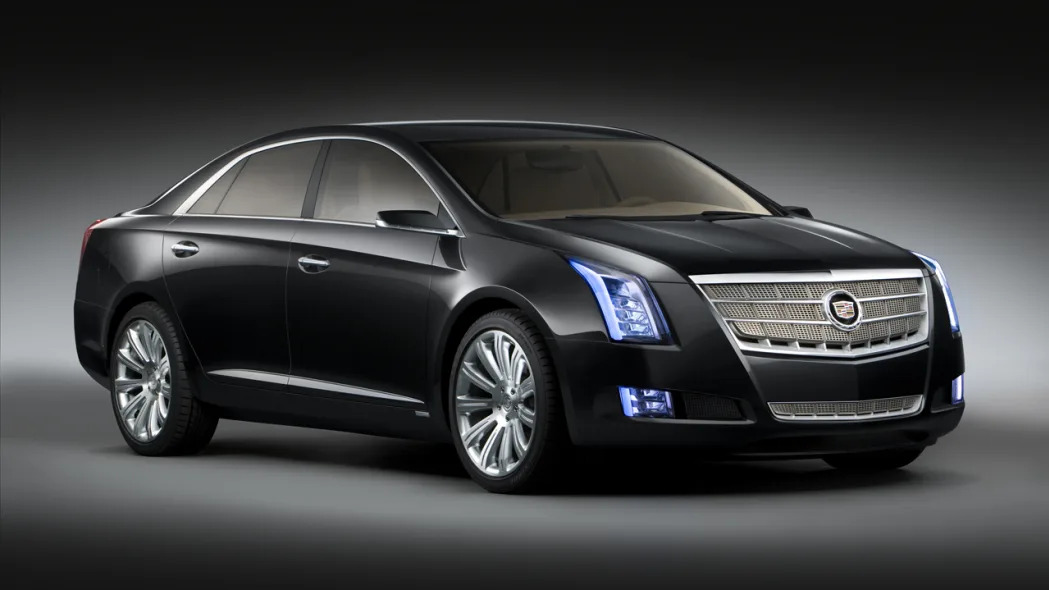

Sign in to post
Please sign in to leave a comment.
Continue